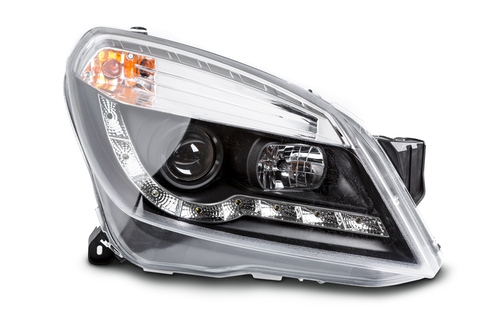Insurance giant China Life invests in energy utility company
At the beginning of December, China Life Insurance (Group) Co. announced that it would invest the equivalent of around 315 million US dollars in the energy utility company Huadian Fuxin Energy Development (HFED). HFED specialises in the development and integration of renewable energies. To date, HFED has raised the equivalent of US$2.35 billion in investment from 13 strategic investors in the insurance, banking and other industries. Upon completion of China Life’s investment, the insurance group will be HFED’s largest strategic investor and third largest shareholder. Products in the energy and photovoltaic sectors that are sold to China and used in business activities in China require CCC certification.

HFED itself is a subsidiary of state-owned energy utility company China Huadian Corp. and said it owned wind and solar power plants with a total capacity of 25.13 million kilowatts at the end of 2020. Institutional investors such as China Life are increasingly looking to green investments to support the economy and businesses in this area, HFED said. China Life Asset Management (CLAM), a subsidiary of China Life, is responsible for the investment itself. With the equivalent of US$675 billion in assets under management, CLAM has already made numerous investments in companies in the so-called “green” industries in recent years. Among others, a “Clean Energy” fund with the equivalent of 1.25 billion US dollars was launched in June 2020.
Climate neutrality will be one of the biggest upcoming trends in the current uncertain environment of the global economy, attracting large sums of money from investors, said Wang Junhui, CIO of China Life during a meeting in May. Chinese insurance companies have recently been focusing more on investing in environmentally and socially responsible companies. According to the China Banking and Insurance Regulatory Commission, Chinese insurers have invested the equivalent of more than 166 billion US dollars in such companies by the end of August 2020. The projects that received the most money were in the transport, energy, water conservation and utilities sectors.
The list of CCC mandatory product groups is constantly expanding and, depending on the category, a mandatory certification China Compulsory Certificate or, since 2019, a CCC Self-Declaration or a voluntary certification must be obtained. The CCC certificate was introduced in 2002 and applies to both imported and Chinese products. CCC stands for China Compulsory Certificate. The Chinese CCC is comparable to other certifications for standardising product quality, such as the European CE system, but there are important differences. We will be pleased to advise you on the scope and requirements of a China CCC certification without obligation.
Please do not hesitate to contact us for further details and consultation. You can contact us via e-mail, or call us (UK: +44 2071931135, Rest of Europe: +49 69 2713769150, US: +1 773 654-2673).
Please don’t hesitate to also use our chat-window in the bottom right corner if you have any questions. (Please check your browser settings if you can’t see the window)
You can also check out our free CCC-Brochure, which can be downloaded right here as a PDF file or you consult our book (in English) “A Brief Guide to CCC: China Compulsory Certification”, which can be found directly here on Amazon.
Here you can download our brochure about the CCC Self-Declaration.
Here you can download our brochure about the voluntary CCAP or CQC certification.
Battery giant CATL invests 2 billion US dollars in new factory
The world’s largest manufacturer of vehicle batteries, CATL, is investing the equivalent of US$2.09 billion in a new manufacturing facility in China to produce a new type of lithium battery. In mid-September 2021, the Chinese company announced the agreement on the project with the municipal government of Yichun, Jiangxi province. The new factory will exclusively produce batteries for electric vehicles such as cars, commercial vehicles and two-wheelers. CATL has not yet given any details about the exact production capacity and the start of construction. According to CATL, the factory will complement the current capacities and is intended to respond to the increased demand in the market. The production of lithium batteries depends, among other things, on components and production equipment requiring CCC certification, as these can only be imported into and sold on the Chinese market in a certified manner.

Including joint ventures, CATL operates 20 production facilities in China and one in Germany, Chinese stockbroker SooChow Securities reported. CATL’s total battery production volume is expected to be about 600 gigawatt hours in 2025, five times the amount from 2020. CATL, whose full name is Contemporary Amperex Technology Co Ltd, has already increased spending on expanding production capacity in the past two years. In December 2020, a plan was revealed to invest the equivalent of US$6.1 billion, then in February the amount was reduced to US$4.5 billion. In order to fund such large sums, CATL raised about US$9.1 billion through a private placement of shares last month.
Batteries and their components have to be CCC certified in order to be exported to China or manufactured locally. CCC certification is a complex project that requires professional support at all stages. For several years, MPR China Certification GmbH has been entrusted with large CCC projects for the vehicle manufacturers Lotus, Tesla and Bugatti. We will be pleased to provide you with non-binding advice on the scope and requirements of a China CCC certification.
Please do not hesitate to contact us for further details and consultation. You can contact us via e-mail, or call us (UK: +44 2071931135, Rest of Europe: +49 69 2713769150, US: +1 773 654-2673).
Please don’t hesitate to also use our chat-window in the bottom right corner if you have any questions. (Please check your browser settings if you can’t see the window)
You can also check out our free CCC-Brochure, which can be downloaded right here as a PDF file or you consult our book (in English) “A Brief Guide to CCC: China Compulsory Certification”, which can be found directly here on Amazon.
Here you can download our brochure about the CCC Self-Declaration.
Here you can download our brochure about the voluntary CCAP or CQC certification.
New Standard GB/T 24551-2021 for Safetytbelt Detection for Seats
Starting on July 1st, 2022 the new standard for safetybelt detection for seats will come into effect. The currently applicable standard GB/T 24551-2009 for safetybelt detection will be superseded by GB/T 24551-2021 on July 1st, 2022. This means that all active certificates for this product group must be updated.

The scope of the standard will be changed. The current version only includes vehicles of category M, under the new standard category N vehicles will also be included.
The updated standard will also include the following adjustments:
- New terms and definitions for visual warning, audible warning, vehicle in normal operation, passenger detection device, internal time and intermittent time.
- Addition of partial technical requirements for visual and audible warning; first and second stage warning.
- Change of the operating condition for the activation of second level warning.
- Addition of technical requirements the for safetybelt reminder for driver and front passenger in the same row as well as for passenger in rear row.
- Additional test methods for the first warning level, the second warning level, and the change of test duration.
As with previous adaptations of GB standards, it is likely that renewed product testing will be required to demonstrate product compliance to the new standard.
We are happy to support you with these product tests as well as with updateing your CCAP or CQC certificates in China, and are always available to answer any further questions you may have,
Are you interested in the new GB standard? Then please contact us for more details and a detailed consultation. Write us an Email or call us at +49-69-2713769150 (EU) or +1-773-654-2673 (US). Please don’t hesitate to also use our chat-window in the bottom right corner if you have any questions. (Please check your browser settings if you can’t see the window)
You can also get detailed information about CCC certification on our website and learn more about GB standards, the process and the costs.
VSTD test standard for lamps for VSCC certification in Taiwan
Taiwan offers many opportunities for car companies. Since 2014, the number of new vehicle registrations has steadily increased, and a record number of new vehicle registrations were reported in 2020, despite the pandemic.
To obtain a VSCC certification for Taiwan, testing in accordance with the relevant Taiwanese Vehicle Safety Testing Directions (VSTD) must also be submitted as part of the documentation submitted for testing and approval.
The testing standards are issued by the Taiwan Ministry of Transportation (MoTC), which has authorized the Vehicle Safety Certification Center (VSCC) to test and approve vehicles and components for the Taiwan market. These tests must be conducted either in a test laboratory approved by the MoTC, or an accredited technical service with its own test laboratories.

Comparability
Although the Vehicle Safety Testing Directions are largely based on the international ECE regulations, testing according to ECE is not recognized by the VSCC. Testing must be conducted in accordance with the VSTD regulations.
Automotive lamps can be complex and must meet several criteria to be considered for testing. There are photometry requirements, installation considerations (VSTD 03 The Installation of Lighting and Light-signaling Devices) and lamp functions to consider:
VSTD 31 Turn Signal Lamps
VSTD 31 specifically addresses the differences between turn signals that are mounted on the front or rear of the vehicle and the tests required. The turn signal performs the directional indicator function when engaged. The area to be illuminated by the turn signal, the acceptable intensity, the orientation of the lamp in relation to the axis of the car and the behavior of the turn signal when several lamps located in the turn signal are illuminated sequentially are all considered.
VSTD 32 fog lights
VSTD 32 defines what defines a lamp a fog lamp and specify test requirements. Unlike turn signals, for example, they are tested for the durability of their continuous output. This means that only minor visual deviations should occur, with no deformities or color changes. In addition, they are subjected to contamination tests and exposed to continuous loads.
VSTD 33 reversing spotlight
VSTD 33 defines the permitted area to be illuminated per square meter, test intervals, as well as lower and upper limits of the measured light values to be met. In contrast to the fog lights, no continuous load is tests are required for reversing lights – which are not intended for continued use over a long period.
VSTD 34 Front headlights
VSTD 34 defines the test requirements as well as permissible values for front headlamps. The front headlights cover a large area to ensure the safety of the vehicle. The illuminated area per square meter must be checked as well as the position and alignment of the beam must be tested. The test requirements as well as permissible values are defined in VSTD 34.
VSTD 35 Taillights
VSTD 35 describes the taillights, which must also produce a uniform light pattern while keeping the intensity of their light within the specified limits. In addition, taillights must be red color-specific and the way in which they are installed in the vehicle must be such that they cannot be manipulated or installed elsewhere.
VSTD 37 Brake lights
VSTD 37 also provides a definition for brake lights and specifies the requirements to be met: They should have a uniform light pattern, be mounted at a specified angle, may only illuminate a specified area, and should be applied for with a product-specific description to the VSCC.
If you still have questions about the process or you would like to have your product checked for VSCC certification requirements, please feel free to contact us.
Send us an e-mail or call us at +49-69-2713 769 150 (EU) or +1 773-654-2673 (US). We will be happy to support you.
We also have the option of answering your questions via online chat. You will find the chat window on the bottom right of every page (if this is not visible, please check your browser settings).



